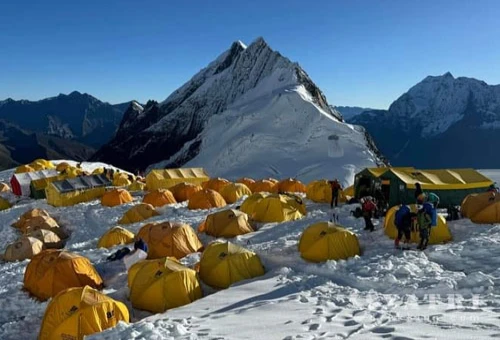🎒 Detailed Packing List – Mt Annapurna I Expedition
👕 Clothing
Base Layers:
Moisture-wicking t-shirts and long-sleeve tops, thermal underwear.
Mid Layers:
Fleece or lightweight down jacket, insulating pullover.
Outer Layers:
Waterproof and windproof jacket, trekking pants, and convertible options.
Additional Items:
Casual wear for evenings, underwear, light cap, warm beanie, neck gaiter.
👟 Footwear
Mountaineering Boots:
Insulated boots such as Scarpa Phantom 8000 or equivalent
Trekking Shoes:
Comfortable shoes for lower altitude trekking and Base Camp.
Camp Shoes:
Sandals or lightweight shoes for use inside teahouses.
🎒 Personal Accessories
Hydration:
Hydration packs or bottles (a minimum of 1–2 liters a day) with purifying tablets.
Sun Protection:
High UV protection sunglasses, sunscreen, lip balm.
Daypack:
Small rucksack for daily essentials (e.g. maps, camera, documents).
Travel Essentials:
Passport, permits, insurance details, and a personal journal.
🥾 Trekking & Climbing Gear
Essential Climbing Equipment:
Helmet, mountaineering harness, ice axe, crampons, carabiners, rappel device, jumar.
Technical Accessories:
A jumer, a safety rope, ascenders, and fixed rope accessories that your guide deems necessary.
📱 Electronics
Headlamp or torch, plus spare batteries.
Power:
Portable power bank and solar charger.
Imaging:
A Camera or Smart Phone, with extra memory cards..
🩹 Health & Hygiene
First Aid:
First aid kit, blister care, personal medications—such as Diamox, Dexamethasone.
Toiletries:
Toothbrush, toothpaste, shampoo, soap, roll-on deodorant, personal hygiene items, fast-drying travel towel.
Health Supplies:
Hand sanitizer and other personal health supplies.
📝 Optional Items
Entertainment:
An e-reader, book, or music player.
Snacks:
Energy bars, gels, nuts, and favorite non-perishable snacks.
Extras:
Trekking map or GPS, waterproof bag for electronics, and documents.

-(1024-x-630-px).webp)

.webp)
.webp)
